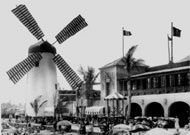The 6,500 permanent
population of 1930 doubled to 13,350 by 1935, and doubled
again to 28,000 by 1940. The winter population in 1935 swelled
to 60,000 and in 1940 reached 75,000. This new surge in the
seasonal population was not limited to the elite, as in the
20's. Tourism rather than land speculation became the major
attraction.
The new wave of tourists sought to forget their gloomy, Depression-ridden
northern cities. Architects for the new hotels responded by
designing buildings with Mediterranean and abstracted ornaments.
These structures from 1930 -1935 form the transition period
on the Beach from Mediterranean-eclectic to the three dimensional,
Streamline, Moderne brand of Art Deco
In 1935 the city of Miami Beach purchased the recreation grounds
of the Flamingo Hotel for $300,000 to create a city park called
Flamingo Park.
In 1936, 38 hotels, 110 apartment buildings, and 320 houses
were constructed. In 1937, another 150 hotels and 508 apartment
buildings opened.
In 1939 Carl Fisher died. The city dedicated a bronze bust
memorial to him near his home on North Bay Road.
| Miami
Beach history guide |
|
|
|














